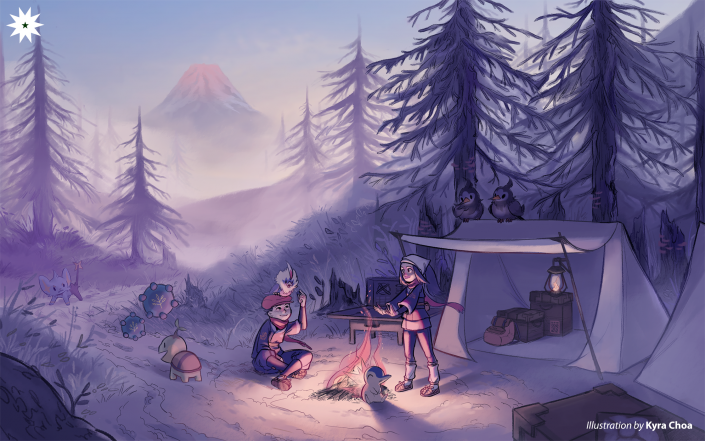Pokémon fans have long clamored for a title that would reinvigorate the mainline series games, giving them a more modern feel and stirring heights. Whether it’s a more open-world experience or a more robust, action-packed set of gameplay mechanics, each fan of the Pokémon community has their own vision for the “perfect” game. But if there’s one thing that most Pokémon fans agree on, it’s that the franchise has been in a rut, with Game Freak seemingly clueless as to what direction its games should go.
This is why the initial teaser trailer for the newest spinoff title, Pokémon Legends: Arceus (PLA), was met with cautious optimism; it appeared to be a promising title but franchise’s fans are not new to disappointment at this point.
Gone are the guarded days, however, for PLA might just be the much-needed tailwind the franchise desperately needs to bring it up to speed with most contemporary games. While the novel features found in the game are nothing new and the graphics are rough around the edges, PLA successfully integrates well-known game mechanics with the Pokémon formula. This refreshing take shows promise that most Pokémon games of late severely lack, and it might be the catalyst needed to jumpstart Pokémon games into a new era.

A spacial rend to the past
While PLA may share similar story beats to previous mainline titles, it’s unconventional in the sense that one is no longer the infallible chosen one. The players start the game as a complete stranger, and most of the characters in-game—even some of the supporting casts—regard one as such. However, as one ventures into ancient Sinnoh—the Hisui region—researching for the Pokédex and fulfilling requests, one slowly builds rapport and earns the trust of people. This journey toward renown feels more organic and well-deserved than one’s typical Poké-journey.
The game expertly portrays what one would expect from an ancient Pokémon world—a harsh, untamed environment, with humankind full of curiosity and doubt. Pokémon are not only branded as dangerous beings; these creatures themselves remind players why such apt labels exist. With the introduction of field encounters where Pokémon can directly attack the player, carelessness can lead one to black out before retaliating with one’s own Pokémon.
Optional side quests are finally formally introduced into the franchise, and they are as varied as they are plenty, riddled with easter eggs. Players get to learn how Drifloon’s kidnapping tendencies came to be known, or how Bidoof gnawed its way into people’s hearts and furniture. Eventually, with each task, one watches the village grow and learns to coexist with Pokémon.
The story itself is nothing new and not all characters get enough character development. A simple feature such as voiced dialogues, which is absent in all mainline Pokémon games, could have done wonders to further color the characters’ personalities.
Not just a simulator
Far from being a one-note title, the game introduces enough new mechanics and a revamped battle system that builds upon the decades-long turn-based formula. As the game is set in a time when people regard Pokémon with fear and skepticism, this unfamiliarity is entrenched not only in the dialogue but also in the gameplay.
One of the hallmarks of every mainline Pokémon game is the completion of the Pokédex, and the same goes for this spinoff. For Hisuains to better understand the creatures surrounding them, players are tasked to research and learn more about mysterious and dangerous Pokémon. Despite initial misconceptions, catching multiple copies of a single Pokémon species isn’t the only method to complete a Pokédex entry. Instances such as evolution and battle encounters, among many others, help players build up their Pokédex.
The Pokémon battles themselves have been reworked. Old moves and status effects have new descriptions and different impacts on the battlefield. The new feature revolving around agile or strong-styled moves adds a new layer of complexity, with each style having its pros and cons. As such, players must decide which style is appropriate for each battle encounter.
Instead of gym battles, one ventures into Hisui to meet its Noble Pokémon—creatures directly blessed by Sinnoh itself, the almighty being that Hisuains worship. As one does so, boss battles are encountered, which are a mixture of real-time and turn-based combat. These battles require dexterity and patience just as much as it necessitates a well-rounded team of Pokémon. While they are relatively easy in terms of difficulty, there are accessible options—such as resuming one’s progress after losing—to keep more casual players from quitting the game in frustration.
Voltorb in a box
In addition, PLA might be the least linear title yet in terms of exploration. While certain regions of Hisui are locked until one progresses in the story, players are given complete freedom to explore the wilderness, so long as one has the necessary “Rideable Pokémon” to traverse certain terrains. One may even encounter Pokémon well beyond their Poké-team’s level, forcing players to be more creative in surveying certain locations. This encourages one to revisit previous locations as the game progresses—but for different reasons this time around.
However, the game is held back by seemingly dated graphics, leaving certain locations or terrains lackluster. Game Freak has little excuse when titles like Breath of the Wild and Xenoblade Chronicles 2 gorgeously utilize the Nintendo Switch’s engine despite its hardware limitations. While the cinematics has improved, for a 2022 title, PLA looks and feels—much like the setting in-game—ancient in today’s standards. The traversable sky, for the most part, is empty with no flocks of Staravia in sight, while the colors and textures all fall flat as a Stunfisk. This can affect one’s immersion within the game. It’s hard to encourage going off the beaten path when there are close to no hidden breathtaking sceneries to greet the player.
What worries most fans, despite PLA’s promising appearance, is Game Freak’s track record of foregoing previous installments’ key features—no matter how well received by fans—for the newest gimmick. This poses a problem considering that the game, despite its flaws and shortcomings, is a great baseline game.
PLA appropriately captures what it sets out to do: to expand the player’s base knowledge on the Pokémon world through a fresh yet familiar journey. It expertly does so by weaving in novel details into the already rich tapestry that is Pokémon lore. Now, the Poké Ball is in Game Freak’s court, but how they plan to utilize this newfound opportunity for future games is still very much unknown.
